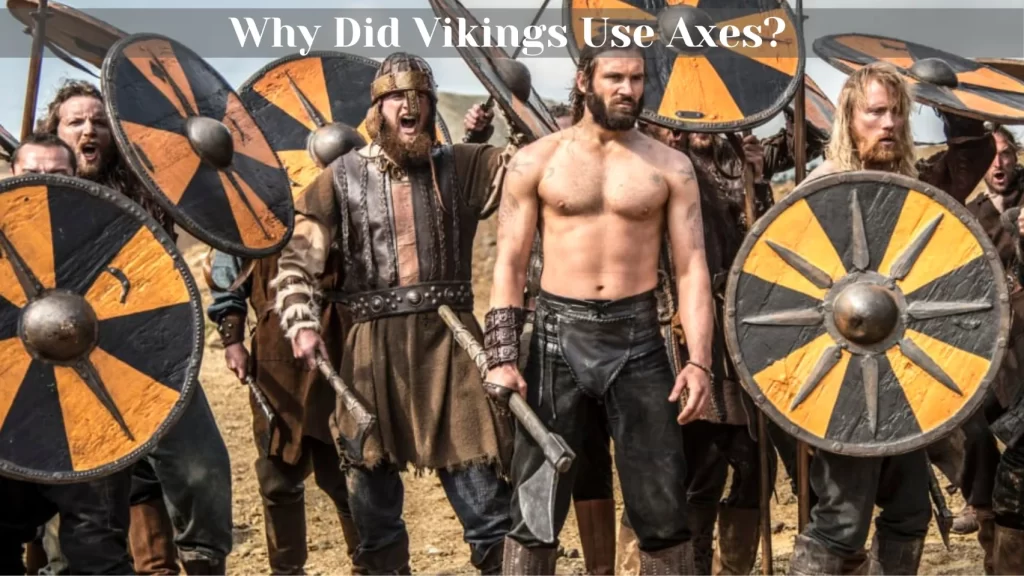The Viking Age, a period of Scandinavian history from the late 8th century to the early 11th century, is widely known for its rich cultural heritage, seafaring ability, and fearsome warriors. Among the many weapons that played a vital role in warfare and everyday tasks were their Viking axes – formidable tools that were extensively used, and also held deep symbolic and mythological significance.
The fierce Norsemen used different types of Viking axes for various purposes, such as multi-functional bearded axe, battle fighting Dane axe, and hand axe for carving and crafting. Let’s take a closer look at the types of Viking axes, how they were made, how they were used, and Viking axe typology in general.
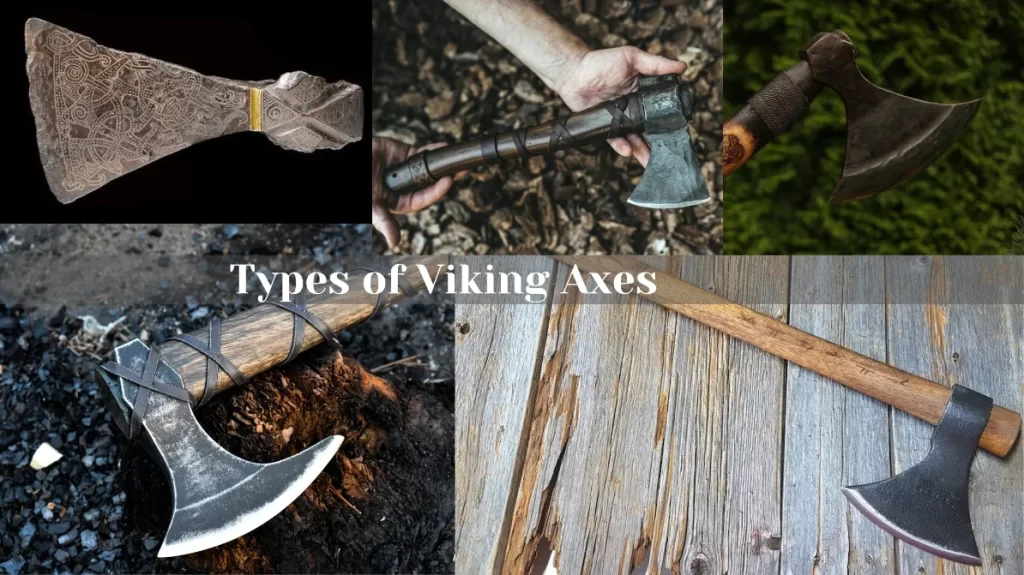
Contents
Types of Viking Axes
There are many variations among the Viking axes depending on their origin, date, purpose, and style. To make sense of this diversity, scholars have developed typologies, which are systems for classifying axes based on their traits and characteristics. Typologies help us to identify and categorize Viking axes, and to understand their evolution and development over time.
The most influential typologies of Viking axes were created by two scholars: Jan Petersen and R.E.M. Wheeler. Petersen published his typology in 1919, based on a study of over 1,000 axes from Norway. He divided the axes into 26 types, labeled from A to Z, according to their shape, size, and decoration.
Wheeler published his typology in 1927, based on a study of over 600 axes from Britain and Ireland. He divided the axes into 9 types, labeled from I to IX, according to their shape and size.
Both typologies are still widely used by archaeologists and historians today, although they have some limitations and criticisms. Let’s learn about some of the main types of Viking axes that we have mostly seen in movies and TV shows, based on a combination of Petersen’s and Wheeler’s typologies.
Bearded Axe
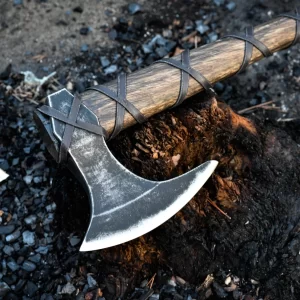 The bearded axe is one of the most common and distinctive types of Viking axes. It is also known as a Skeggøx.
The bearded axe is one of the most common and distinctive types of Viking axes. It is also known as a Skeggøx.
The bearded axe has a long and narrow head that curves downwards at the lower end, forming a hook or a beard. The beard extends the cutting edge of the axe and allows the user to grip the haft behind it for more control and leverage.
The bearded axe was mainly used as a weapon, both on land and at sea. It was effective for chopping, slashing, hooking, and pulling. It could also be thrown as a missile or used as a tool for woodwork or shipbuilding.
The bearded axe had several advantages over other types of axes: it was light, fast, versatile, and easy to make. However, it also had some disadvantages: it was fragile, prone to breaking or bending, and required frequent sharpening because of thin blade.
The bearded axe was very popular among the Vikings from the 8th to the 10th century. It is often depicted in art and literature as a symbol of Viking warriors and heroes. Best of all, the bearded axe type became more famous after we it was used by the Ragnar Lothbrok in Vikings series.
Hand Axe
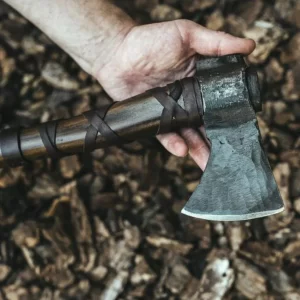 Another common type of Viking axes is Hand Axe. The hand axe has a symmetrical or slightly curved short and broad head with a short haft that fits comfortably in one hand.
Another common type of Viking axes is Hand Axe. The hand axe has a symmetrical or slightly curved short and broad head with a short haft that fits comfortably in one hand.
The hand axe was mainly used as a weapon, especially for close combat or boarding actions. It was effective for hacking, stabbing, or throwing. It could also be used as a tool for various tasks such as chopping wood or cutting meat.
The hand axe had several advantages over other types of axes: it was compact, sturdy, cheap, and easy to carry. However, it also had some disadvantages: it was heavy, slow, limited in range, and required skill and strength to use.
The hand axe was widely used by the Vikings from the 9th to the 11th century. It is often found in graves and hoards as a sign of wealth and status.
Dane Axe
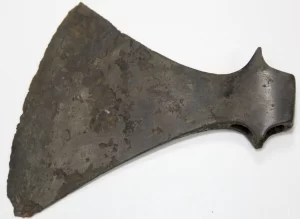 One of the famous Viking axes is the Dane axe, also known as Viking battle-axe. The Dane axe has a long and thin head that is shaped like a crescent or a wing, and a long haft that can reach up to 1.5 meters in length.
One of the famous Viking axes is the Dane axe, also known as Viking battle-axe. The Dane axe has a long and thin head that is shaped like a crescent or a wing, and a long haft that can reach up to 1.5 meters in length.
The Dane axe was one of the most feared Viking weapons, mainly used as a weapon, especially for warfare and raiding. It was effective for cleaving, smashing, breaking through shields, or piercing. It could also be used as a polearm or a spear.
The Dane axe had several advantages over other types of axes: it was powerful, intimidating, and had a long reach. However, it also had some disadvantages: it was heavy, cumbersome, and required two hands to use.
The Dane axe was popular among the Vikings from the 10th to the 11th century. It is often associated with the elite warriors and nobles who served as the king’s bodyguards or personal troops.
Valhalla Throwing Axe
 The Valhalla throwing axe is a type of Viking axe that is also known as a Frakka, or a throwing-axe. The Valhalla throwing axe has a small and light head that is shaped like a triangle or a diamond, with a short haft that can fit in one hand.
The Valhalla throwing axe is a type of Viking axe that is also known as a Frakka, or a throwing-axe. The Valhalla throwing axe has a small and light head that is shaped like a triangle or a diamond, with a short haft that can fit in one hand.
The Valhalla throwing axe was mainly used as a weapon, especially for hunting or skirmishing. While it may not have been the primary weapon of choice in close combat, the Valhalla throwing axe played a crucial role in transitional combat scenarios. It was effective for hurling, striking, or distracting. It could also be used as a backup weapon or a tool for various tasks such as cutting ropes or leather.
The Valhalla throwing axe was agile, accurate, and easy to throw. However, it also had some disadvantages: it was weak, limited in range, and hard to retrieve.
Mammen Axe
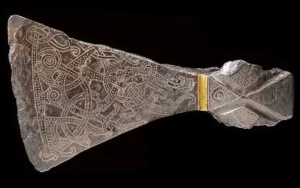 The Mammen axe, named after the Mammen village in Denmark where it was discovered, is a type of Viking axe renowned for its intricate and ornate design. It features lavish engravings and inlays, making it a true work of art.
The Mammen axe, named after the Mammen village in Denmark where it was discovered, is a type of Viking axe renowned for its intricate and ornate design. It features lavish engravings and inlays, making it a true work of art.
The Mammen axe has a medium-sized and curved head that is richly decorated with intricate patterns and motifs. The Mammen axe has a medium-length haft that is also adorned with carvings and metal fittings.
The Mammen axe was mainly used as a symbol, rather than a weapon or a tool. It was a sign of prestige, power, and piety. It was often used for ceremonial purposes, such as Viking rituals, sacrifices, or burials.
There’s no evidence in the history that could prove fighting advantages of the Mammen axe: it was only known for it’s beauty, uniqueness, and value. However, it was expensive, rare, and impractical.
Read about the most expensive Viking weapon, and guess what? It was not an axe!
Cross Axe
 This was more like an axe of Christianity – the cross, or a crusader axe. The head of cross axe was trimmed hollow from inside to create a (T shaped) Holy Cross. The cross axe has a long haft that can reach up to 2 meters in length.
This was more like an axe of Christianity – the cross, or a crusader axe. The head of cross axe was trimmed hollow from inside to create a (T shaped) Holy Cross. The cross axe has a long haft that can reach up to 2 meters in length.
The Christian community among the Vikings mainly used cross axe to showcase their religion. It was used as a weapon, especially for crusading and fighting against the enemies of Christianity. It was effective for smashing, crushing, or breaking. It could also be used as a siege weapon or a battering ram.
The cross axe was powerful, destructive, and had a wide reach because of long handle. However, it also had some disadvantages: it was heavy, unwieldy, not so agile, and required two hands to use.
Now you know the types of Viking axes, also learn about what were Viking axes actually used for!
Materials of Viking Axes
Heads
The Vikings made their axes using iron and steel. Iron, one of the most abundant metals in Scandinavia, was the primary material for the axe head. It was often reinforced with steel edges that were hand-forged and carefully woven into the iron body, producing a robust blade that could withstand harsh impacts.
Steel was also used for axe blades, but it was less common than iron. Steel was more expensive to produce, but it was also stronger and more durable than iron.
Hafts (Handles)
Handles were typically made of durable wood like ash and oak. These were chosen for their flexibility, strength, and shock-absorption properties. Additionally, handles were sometimes wrapped in leather for a more comfortable and secure grip.
Final Words
We have learned about the types of Viking axes, from the intricate Mammen Axe to the fearsome Dane Axe, from religious explanatory cross axe to most famous bearded axe (also known as Ragnar axe), each reflecting the unique demands and skills of its time. We’ve also looked into their materials, designs, and uses.
The Viking axes are not only fascinating and versatile tools, but also reveal a lot about the history, culture, and legacy of the Norsemen. The legacy of Viking axes endures, and it invites us to journey deeper into the rich tapestry of the Viking Age, where steel, wood, and leather tell a story that will never fade into history.
Frequently Asked Questions
What did Viking axes really look like?
Viking axes varied in appearance depending on the type of axe and the region in which it was made. However, some general appearance of Viking axes include:
- Long, narrow blades: Many Viking axes had long, narrow blades that were ideal for slashing and stabbing.
- Strong hafts: Viking axe hafts were typically made from hardwood, such as ash or oak, and were often reinforced with metal bands.
- Intricate decorations: Some of the Viking axes were decorated with intricate carvings and symbols, reflecting the personal style and cultural identity of the owner.
What was the most common Viking axe?
The most common Viking axe was the bearded axe, also known as the Skeggøx in Old Norse. Bearded axes were ideal for both combat and everyday tasks, making them a versatile tool for the Vikings. It was popular among all classes of Vikings, from farmers to warriors to nobles.
What were Viking throwing axes called?
Viking throwing axes were called Franciscas. Franciscas were small, lightweight axes with a short blade and a well-balanced design. They were very effective at striking targets at a distance, and were often used in battle to break enemy formations or to harass enemy troops.
What were the primary uses of Viking battle axes?
Viking battle axes were designed for close-quarter combat, and their powerful blows could cleave through armor. While they were formidable on the battlefield, they could also be employed for general-purpose woodcutting and other utilitarian tasks.


